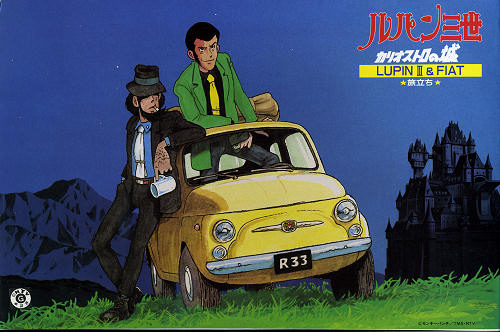
Gunze Sangyo 1/24 Fiat 500 'Lupin III & Fiat'
| KIT #: | G-341 |
| PRICE: | $47.50 SRP |
| DECALS: | Plates and instruments. |
| REVIEWER: | Scott Van Aken |
| NOTES: | Includes resin figures and P.E. parts |

| HISTORY |
In 1957 Fiat launched the
successor to its previous model the Topolino .
The designer was Dante Giacosa who was to become a legend in the
automobile design world.
The vehicle drew heavily on The ground work Giacosa had done for the 400 ,
which was a prototype of a minimalist two-seater utility car . It also drew
heavily on the slightly larger 600 but differed dramatically in the engine
department by having an all new 479cc overhead valve, air-cooled vertical
twin mated to a four speed crash gearbox.
With 13 bhp on tap it's neck breaking acceleration did not exactly conjure up images of a would-be Ascari at the wheel.
So came the likes of Carlo Abarth,
Giannini, Nardi, who had a field-day offering after-market accessories and
bolt-on tuning parts so the young Italians could go racing around the
streets.
FIAT also offered, between The years 1958-60, a Sport version which
had a one piece roof unlike the standard version which had a rather useful
fold back sunroof . This particular model had 21 bhp which improved he
performance dramatically.
The major 500 models are as follows:
June 1957 Basic Economica 500 Nuova with 13bhp
Late 1957 revised model called The Normale with 15 bhp also with
wind up windows.
1958-60 Sport with 499.5cc with 21bhp
1960 The 'D' model came along with revised engine and trim.
The first major change came in 1965 with The 'F' when the car lost
its 'suicide doors' and gave way to front hinged doors.
The Lux version did not come until 1969-75 with full carpet and
plastic revised dashboard and lots of bright work.
Less unknown was The 500 'R' that was never imported to The UK which was
the 'L' body on the new 126 chassis.
Being one of the easiest cars to park, one of the cheapest classic cars to
buy, very economical to run and repair makes The 500 not only one of the
most stylish mass-produced cars ever produced but an incredibly roust town
car for The person who wants to stand-out from The crowd.
In addition it has excelled for many people throughout Europe as a
businesslike touring car as well as competition car.
The above history was unashamedly pinched from the Internet. Your editor can recall seeing these things buzzing around at various SCCA events in the 60s and 70s. He can also recall that they were not designed for taller people, having scrunched himself into one at one time and needed considerable effort to get out later!
| THE KIT |
 If you have had the chance to read
the previews of the other Gunze car kits I have bought over the years, then
you know that what you'll get is a well molded and well detailed kit of
what is a very small car. This one includes two resin figures for a
Japanese anime movie that seems to be set in a mythical European country (which is great for marketing
these kits). These two figures are from a very early Hayao Miyazake movie,
"The Castle of
Cagliostro" and are the good guys.
If you have had the chance to read
the previews of the other Gunze car kits I have bought over the years, then
you know that what you'll get is a well molded and well detailed kit of
what is a very small car. This one includes two resin figures for a
Japanese anime movie that seems to be set in a mythical European country (which is great for marketing
these kits). These two figures are from a very early Hayao Miyazake movie,
"The Castle of
Cagliostro" and are the good guys.
The figures are very well molded in resin and should not be a problem when assembling. Vinyl is included for the tires, seats, and the sun-roof. The chrome plating is very well done and you get metal axles. The single sprue of white plastic for the majority of the kit are well molded and free from the usual glitches. There is no engine with this one which begs the price of the kit and the fact that one of the features of this car in the movie is the hopped up engine of the car in several chase scenes. The one-piece body is molded in yellow (to preclude painting, no doubt). The large clear sprue includes the dash where one is supposed to paint ivory aside from the location of the lone instrument. One thing I would have liked to have seen included was the Boys anti-tank rifle that was the weapon of choice of the guy in black.
Instructions are well done and mostly in Japanese. No Englishmen were harmed in the writing of these instructions. Colors are given in English as is a warning that it isn't suitable for children under 3. I'm sure the color references are for Gunze paints as every Japanese model company except Tamiya references them. Decals are for the plates, instrument, and the eyes of the figures.
| CONCLUSIONS |
Once again, I was seduced by the unusual and the quirky. Despite that, it does seem as if this will make into a really fine model. The detail level is really quite good and the resin well done. However, the lack of an engine and photo etch that are parts of other Fiat 850 kits along with the very high US MSRP makes this a kit that one really needs to think about before buying.
Kit courtesy of store credit.
If you would like your product reviewed fairly and fairly quickly, please contact the editor or see other details in The Note to Contributors.